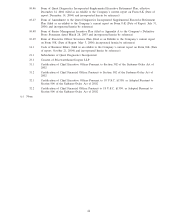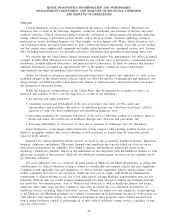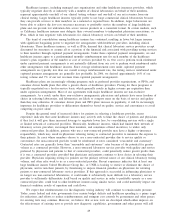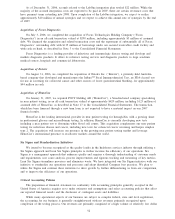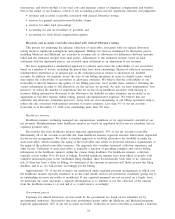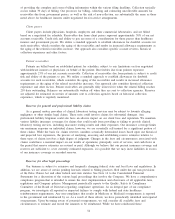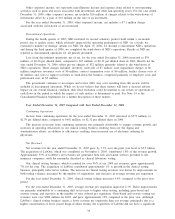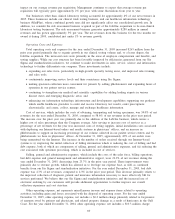Quest Diagnostics 2006 Annual Report Download - page 74
Download and view the complete annual report
Please find page 74 of the 2006 Quest Diagnostics annual report below. You can navigate through the pages in the report by either clicking on the pages listed below, or by using the keyword search tool below to find specific information within the annual report.transactions, and about one-half of our total costs and expenses consist of employee compensation and benefits.
Due to the nature of our business, several of our accounting policies involve significant estimates and judgments:
•revenues and accounts receivable associated with clinical laboratory testing;
•reserves for general and professional liability claims;
•reserves for other legal proceedings;
•accounting for and recoverability of goodwill; and
•accounting for stock-based compensation expense.
Revenues and accounts receivable associated with clinical laboratory testing
The process for estimating the ultimate collection of receivables associated with our clinical laboratory
testing involves significant assumptions and judgments. Billings for services reimbursed by third-party payers,
including Medicare and Medicaid, are recorded as revenues net of allowances for differences between amounts
billed and the estimated receipts from such payers. Adjustments to the estimated receipts, based on final
settlement with the third-party payers, are recorded upon settlement as an adjustment to net revenues.
We have implemented a standardized approach to estimate and review the collectibility of our receivables
based on a number of factors, including the period they have been outstanding. Historical collection and payer
reimbursement experience is an integral part of the estimation process related to allowances for doubtful
accounts. In addition, we regularly assess the state of our billing operations in order to identify issues, which
may impact the collectibility of receivables or allowance estimates. We believe that the collectibility of our
receivables is directly linked to the quality of our billing processes, most notably those related to obtaining the
correct information in order to bill effectively for the services we provide. As such, we have implemented “best
practices” to reduce the number of requisitions that we receive from healthcare providers with missing or
incorrect billing information. Revisions to the allowances for doubtful accounts estimates are recorded as an
adjustment to bad debt expense within selling, general and administrative expenses. We believe that our
collection and allowance estimation processes, along with our close monitoring of our billing operations, help to
reduce the risk associated with material revisions to reserve estimates. Less than 5% of our net accounts
receivable as of December 31, 2006 were outstanding more than 150 days.
Healthcare insurers
Healthcare insurers, including managed care organizations, reimburse us for approximately one-half of our
net revenues. Reimbursements from healthcare insurers are based on negotiated fee-for-service schedules and on
capitated payment rates.
Receivables due from healthcare insurers represent approximately 25% of our net accounts receivable.
Substantially all of the accounts receivable due from healthcare insurers represent amounts billed under negotiated
fee-for-service arrangements. We utilize a standard approach to establish allowances for doubtful accounts for
such receivables, which considers the aging of the receivables and results in increased allowance requirements as
the aging of the related receivables increases. Our approach also considers historical collection experience and
other factors. Collection of such receivables is normally a function of providing complete and correct billing
information to the healthcare insurers within the various filing deadlines. For healthcare insurers, collection
typically occurs within 30 to 60 days of billing. Provided healthcare insurers have been billed accurately with
complete information prior to the established filing deadline, there has historically been little to no collection
risk. If there has been a delay in billing, we determine if the amounts in question will likely go past the filing
deadline, and if so, we will reserve accordingly for the billing.
Approximately 7% of our net revenues are reimbursed under capitated payment arrangements in which case
the healthcare insurers typically reimburse us in the same month services are performed, essentially giving rise to
no outstanding accounts receivable at month-end. If any capitated payments are not received on a timely basis,
we determine the cause and make a separate determination as to whether or not the collection of the amount
from the healthcare insurer is at risk and if so, would reserve accordingly.
Government payers
Payments for clinical laboratory services made by the government are based on fee schedules set by
governmental authorities. Receivables due from government payers under the Medicare and Medicaid programs
represent approximately 14% of our net accounts receivable. Collection of such receivables is normally a function
53



